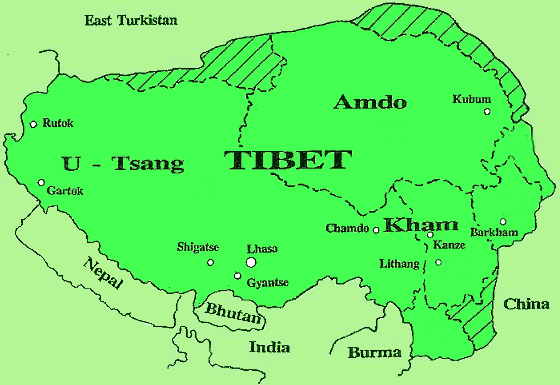Tibet refers to the entity composing of U-Tsang, Kham and Amdo provinces. It should not be confused to mean only the Tibet Autonomous Region (TAR), which is less than half the landmass of Tibet with only one-third of the total Tibetan population.

- Land Size: 2.5 million square kilometres, which includes U-Tsang, Kham and Amdo provinces. Tibet Autonomous Region, consisting of U-Tsang and a small portion of Kham, consists of 1.2 million square kilometres. The bulk of Tibet lies outside the TAR.
- Capital: Lhasa
- Population: 6 million Tibetans and an estimated 7.5 million Chinese, most of whom are in Kham and Amdo.
- Language: Tibetan (of the Tibeto-Burmese language family). The official language is Chinese.
- Staple Food: Tsampa (roasted barley flour)
- National Drink: Salted butter tea
- Typical Animals: Wild yak, Bharal (blue) sheep, Musk deer, Tibetan antelope, Tibetan gazelle, Kyang (wild ass), Pica, Panda
- Typical Birds: Black necked crane, Lammergeier, Great crested grebe, Bar-headed goose, Ruddy shel duck, Ibis-bill
- Major Environmental Problems: Rampant deforestation in Eastern Tibet, poaching of large mammals, nuclear waste, degradation of grassland
- Average Altitude: 4,000 metres or 13,000 feet above sea level.
- Highest Mountain: Chomo Langma (Mt. Everest) 29,028 ft.
- Average Rainfall: Varies widely. In the west it is 1 mm in Jan. to 25 mm in July. In the east, it is 25-50 in Jan. and 800 in July
- Average Temperature: July–14.5 degrees celcius (58 F) January–minus 16.5 degrees celcius (24 F)
- Mineral Deposits: Borax, uranium, iron, chromite, gold
- Major Rivers: Yarlung Tsangpo (Brahmaputra in India), Machu (Yellow River in China), Drichu (Yangtse in China), Senge Khabab (Indus in India), Phungchu (Arun in India), Gyalmo Ngulchu (Salween in Burma) and Zachu (Mekong in Thailand, Vietnam, Cambodia, Laos).
- Economy: Tibetans: predominantly in agriculture and animal husbandry. Chinese: predominantly in government, commerce and the service sector.
- Provinces: U-Tsang (Central Tibet), Amdo (N.E. Tibet), Kham (S.E. Tibet)
- Bordering Countries: India, Nepal, Bhutan, Burma, China
- National Flag: Snow lions with red and blue rays. Outlawed in Tibet.
- Religious Leader: The 14th Dalai Lama. In exile in Dharamsala, India.
- Political Leader: The Sikyong Dr Lobsang Sangay. In exile in Dharamsala, India.
- Government in Exile: Parliamentary
- Current Government: Communist
- Relationship with the P.R.C.: Colonial
- Legal (Political) Status: Occupied
- Destruction of Monasteries since Occupation: about 6,000
- Death of Tibetans since Occupation: 1.2 million
